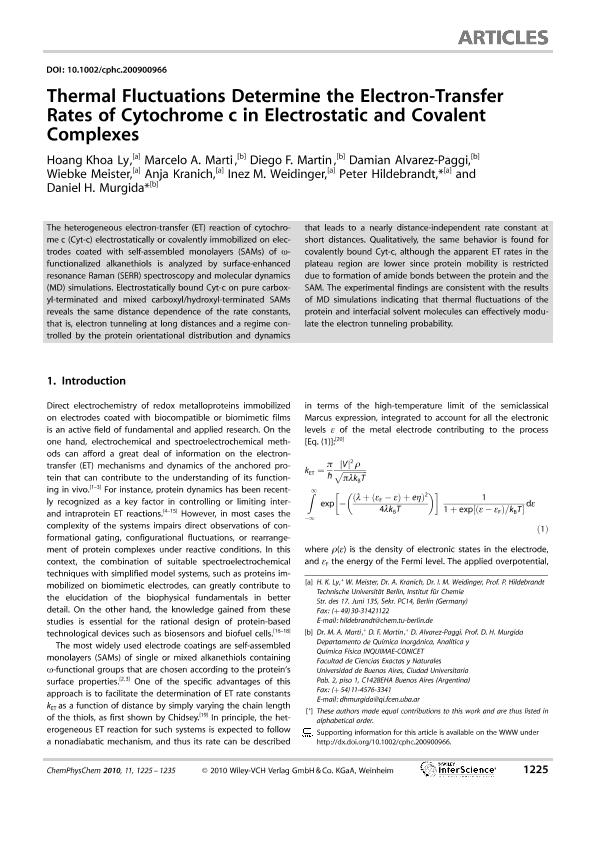Artículo
Thermal fluctuations determine the electron-transfer rates of cytochrome c in electrostatic and covalent complexes
Ly, Hoang Khoa; Marti, Marcelo Adrian ; Martín, Diego Federico
; Martín, Diego Federico ; Álvarez Paggi, Damián Jorge
; Álvarez Paggi, Damián Jorge ; Meister, Wiebke; Kranich, Anja; Weidinger, Inez M.; Hildebrandt, Peter; Murgida, Daniel Horacio
; Meister, Wiebke; Kranich, Anja; Weidinger, Inez M.; Hildebrandt, Peter; Murgida, Daniel Horacio
 ; Martín, Diego Federico
; Martín, Diego Federico ; Álvarez Paggi, Damián Jorge
; Álvarez Paggi, Damián Jorge ; Meister, Wiebke; Kranich, Anja; Weidinger, Inez M.; Hildebrandt, Peter; Murgida, Daniel Horacio
; Meister, Wiebke; Kranich, Anja; Weidinger, Inez M.; Hildebrandt, Peter; Murgida, Daniel Horacio
Fecha de publicación:
04/2010
Editorial:
Wiley VCH Verlag
Revista:
Chemphyschem
ISSN:
1439-4235
Idioma:
Inglés
Tipo de recurso:
Artículo publicado
Clasificación temática:
Resumen
The heterogeneous electron-transfer (ET) reaction of cytochrome c (Cyt-c) electrostatically or covalently immobilized on electrodes coated with self-assembled monolayers (SAMs) of ω-functionalized alkanethiols is analyzed by surface-enhanced resonance Raman (SERR) spectroscopy and molecular dynamics (MD) simulations. Electrostatically bound Cyt-c on pure carboxyl-terminated and mixed carboxyl/hydroxyl-terminated SAMs reveals the same distance dependence of the rate constants, that is, electron tunneling at long distances and a regime controlled by the protein orientational distribution and dynamics that leads to a nearly distance-independent rate constant at short distances. Qualitatively, the same behavior is found for covalently bound Cyt-c, although the apparent ET rates in the plateau region are lower since protein mobility is restricted due to formation of amide bonds between the protein and the SAM. The experimental findings are consistent with the results of MD simulations indicating that thermal fluctuations of the protein and interfacial solvent molecules can effectively modulate the electron tunneling probability. © 2010 Wiley-VCH Verlag GmbH & Co. KGaA, Weinheim.
Archivos asociados
Licencia
Identificadores
Colecciones
Articulos(INQUIMAE)
Articulos de INST.D/QUIM FIS D/L MATERIALES MEDIOAMB Y ENERGIA
Articulos de INST.D/QUIM FIS D/L MATERIALES MEDIOAMB Y ENERGIA
Citación
Ly, Hoang Khoa; Marti, Marcelo Adrian; Martín, Diego Federico; Álvarez Paggi, Damián Jorge; Meister, Wiebke; et al.; Thermal fluctuations determine the electron-transfer rates of cytochrome c in electrostatic and covalent complexes; Wiley VCH Verlag; Chemphyschem; 11; 6; 4-2010; 1225-1235
Compartir
Altmétricas



